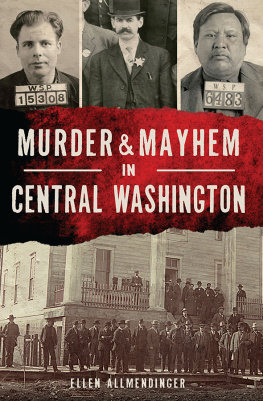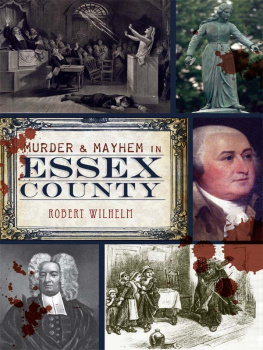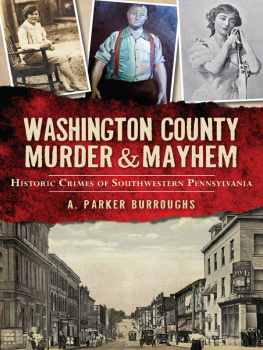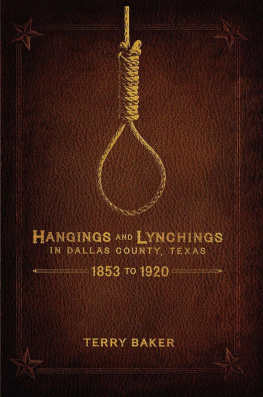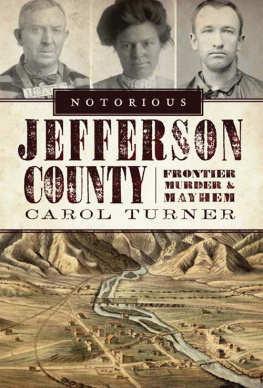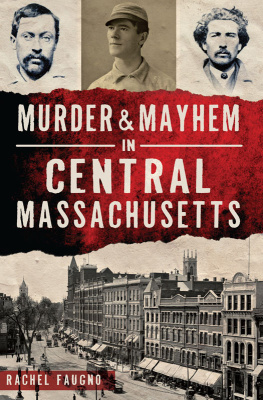


Published by The History Press
Charleston, SC
www.historypress.com
Copyright 2021 by Ellen Allmendinger
All rights reserved
First published 2021
e-book edition 2021
ISBN 978.1.43967.207.5
Library of Congress Control Number: 2020945791
print edition ISBN 978.1.46714.813.9
Notice: The information in this book is true and complete to the best of our knowledge. It is offered without guarantee on the part of the author or The History Press. The author and The History Press disclaim all liability in connection with the use of this book.
All rights reserved. No part of this book may be reproduced or transmitted in any form whatsoever without prior written permission from the publisher except in the case of brief quotations embodied in critical articles and reviews.
CONTENTS
ACKNOWLEDGEMENTS
This book is dedicated to all Central Washington history lovers. May it serve as a reminder of the long-forgotten criminal activity, brutality and mayhem that once existed in Central Washingtons early history.
A huge thanks goes to my son, Zakary, for patiently enduring my countless hours of research and writing. Without your patience and understanding, this book would not be possible.
There is no possible way to list all my friends and acquaintances who were a constant source of encouragement without writing an entire book dedicated to them. Without your ongoing support and continual encouragement to keep researching and writing, this book may never have left the memory of my computer.
Many other individuals and institutions are also due credit for assisting me with research for this book. Some of you deserve special attention: the employees and volunteers of the Yakima Valley Museum and the Kittitas County Museum who assisted me with historical questions and negotiating through archived materials; the Ellensburg Public Library and Yakima Valley Regional Library employees who were extremely helpful in compiling historic information for the stories shared within; members and volunteers of the Yakima Valley Genealogical Library who spent time pointing me in the right direction while researching the individuals contained within these pages; and the National Archives, Library of Congress, Washington State Digital Archives and ancestry.com, which were also wonderful sources of historical information, documents and resources.
A special thanks also goes to my commissioning editor and publishing company for guiding me through the process of submitting something acceptable enough to publish again!
Last but not least, a huge thank-you goes to all the Central Washington history lovers out there! Your ongoing interest in history is what keeps me going. May you enjoy the contents shared within.
INTRODUCTION
Of the Washington Territory, Central Washington (Kittitas, Yakima and Benton Counties) was one of the last regions in Washington State to become permanently settled by white settlers. With its sagebrush-covered landscape and lack of early irrigation and transportation, Central Washington was sparsely populated by white settlers while areas such as Walla Walla, Seattle and Tacoma grew.
As white settlers began traveling east, west and even north, through Central Washington, some chose to stay, laying claim to lands they would soon begin farming. Soon unincorporated areas that served as places of commerce began rising from the sagebrush.
With the arrival of the railroad, small communities became more formalized in Central Washington as a form of supporting the railroad and rail travel. Ultimately, the combination of farming, commerce and the railroad soon placed the area on the map, and a rapid growth of population occurred.
Along with that rapid growth came various issues other populated regions were also experiencing. One such issue concerned social strife and crime. These events varied in nature but included assassinations, bootlegging, shootings, hangings, riots, burglaries and posse outlaw gangs. Such activities shocked and horrified not only the citizens of the communities in which they occurred but also many in the Pacific Northwest.
The intent of this book is to share a few of those long-forgotten and historic crimes. However, it is important to remember that those involved in the stories within this book may still have living descendants. These stories are shared only to help relay historical events, not to place any form of judgment on any living or deceased family member of those discussed herein. The actions of one individual do not inform the character of those related to him or her.
PART I
KITTITAS COUNTY, WASHINGTON
THE ASSASSINATION OF DR. LYON (ROSLYN)
The community of Roslyn, Washington, began with the discovery of coal in 1883. Three years later, the area was platted and became a coal company town. The coal mines provided the main source of employment and also owned most of the citys businesses. As a community, Roslyns successes were a direct result of the success of mining in the area. Likewise, the communitys failures were often centered on mining failures. Not unfamiliar with tragedy, Roslyns citizens experienced more than their share of tragic disasters in the late 1890s and early 1900s.
As a company town, the Northern Pacific Coal Company provided several services for its employees. Such services included the hiring of physicians to care for employees and their families. One of the first physicians hired to work for the company was Dr. John H. Lyon. Dr. Lyon experienced the devastating effects of coal mining accidents through the care of his patients. Such tragic effects on his patients lives may have also been the direct cause for the loss of his own life years later.
Born in Pennsylvania in 1852, John H. Lyon was about thirty-five years old when he arrived in Roslyn, Washington, as a doctor and single man around 1887. Little is known about his early life or his medical education prior to his arrival. Once in Roslyn, Dr. Lyon worked alongside Dr. Sloan as a Northern Pacific Coal Company physician.
Two years after his arrival in Roslyn, in September 1889, John married Jesse Mable Condit in Ellensburg, Washington. Born in 1864 in New Jersey, Jessie was twelve years younger than John when they married. It is unknown why Jessie had traveled across the country or when she arrived Kittitas County, although her arrival appears to have occurred within four years of their marriage.
John and Jessie lived in a home in Roslyn while John continued to work as a railroad company doctor. He earned one dollar per month for each miner he treated or prescribed drugs for. Practicing as a physician was not Johns only invested interest in Kittitas County. He was also very social and politically active and appeared to be living a happily married life. Sadly, he would soon endure a personal tragedy.
On April 16, 1892, three years they were married, the couple welcomed their first child, a baby daughter, into the world. Just weeks after their daughters birth, Jesse died on May 4, 1892. After her death, John had Jesses body transported back to New Jersey for burial in the Pleasantdale Cemetery. She was laid to rest at the cemetery where other members of her family had been interred. Now a widower with a baby daughter to care for, John remained in Roslyn practicing medicine. He would have little time to grieve his wifes passing before disaster would strike the Roslyn community.
Next page
